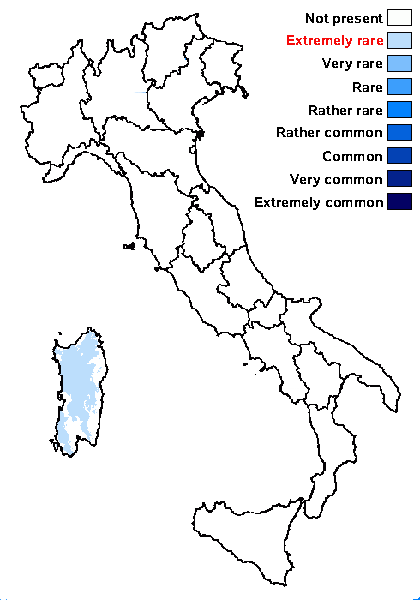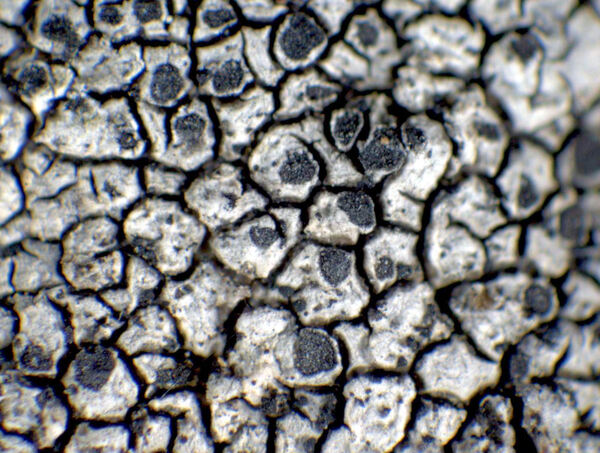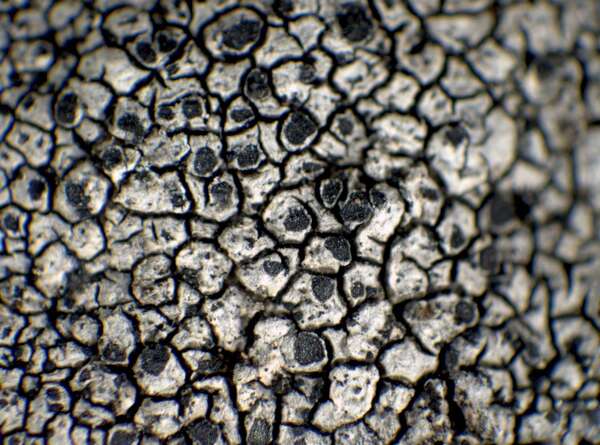Rinodina fimbriata Körb.
Parerga Lichenol.: 76, 1859.
Synonyms: Rinodina confragosa var. inundata (Blomb. ex Th. Fr.) H. Olivier; Rinodina exigua var. inundata Blomb. ex Th. Fr.
Distribution: C - Sar (Rizzi & al. 2011, Nascimbene & al. 2023).
Description: Thallus crustose, episubstratic, 0.3-0.7 mm thick, pale grey to brown-black, rimose-areolate, often with a conspicuous, blue-black, fimbriate prothallus. Apothecia cryptolecanorine to lecideine, appearing aspicilioid, persistently immersed to rarely adnate, 0.4-0.8 mm across, with a flat, brown-black disc and a thin, soon excluded thalline margin. Epithecium reddish brown, K-; hymenium colourless, 90-120 µm high; paraphyses 1.5-2 µm thick at mid-level, the apical cells 3-4 µm wide, with a dark cap; hypothecium colourless, up to 200 µm high. Asci 8-spored, clavate, the K/I+ blue tholus penetrated by a faintly amyloid apical cushion with parallel or diverging flanks, the wall K/I-, surrounded by a K/I+ blue outer layer, Lecanora-type. Ascospores 1-septate, brown, ellipsoid, (19-)22-26(-31) x 11-17 µm, Mischoblastia-type, with heart-shaped lumina. Photobiont chlorococcoid. Spot tests: K-, C-, KC-, P-, UV-. Chemistry: without lichen substances.Note: a very rarely collected species found on periodically inundated siliceous rocks in mountain creeks and rivers; several stations might have disappeared as a consequence of environmental changes.
Growth form: Crustose
Substrata: rocks
Photobiont: green algae other than Trentepohlia
Reproductive strategy: mainly sexual
Periodically submerged (e.g. in creeks)
Commonnes-rarity: (info)
Alpine belt: absent
Subalpine belt: absent
Oromediterranean belt: absent
Montane belt: extremely rare
Submediterranean belt: absent
Padanian area: absent
Humid submediterranean belt: extremely rare
Humid mediterranean belt: absent
Dry mediterranean belt: absent

Predictive model
Growth form: Crustose
Substrata: rocks
Photobiont: green algae other than Trentepohlia
Reproductive strategy: mainly sexual
Periodically submerged (e.g. in creeks)
Commonnes-rarity: (info)
Alpine belt: absent
Subalpine belt: absent
Oromediterranean belt: absent
Montane belt: extremely rare
Submediterranean belt: absent
Padanian area: absent
Humid submediterranean belt: extremely rare
Humid mediterranean belt: absent
Dry mediterranean belt: absent

Predictive model
 INDEX FUNGORUM
INDEX FUNGORUM
 GBIF
GBIF




